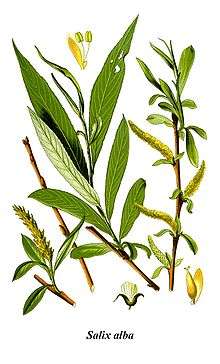Cupping therapy
Cupping therapy is a form of alternative medicine in which a local suction is created on the skin. Cupping has been characterized as a pseudoscience, and its practice as quackery.[1][2] There is no good evidence it has any health benefits, and there are some risks of harm, especially from wet cupping and fire cupping.
| Cupping therapy | |
|---|---|
 Cupping and bloodletting set, from London, England, dating from 1860–1875 | |
| Alternative therapy | |
| Benefits | Placebo |
| This article is part of a series on |
| Alternative and pseudo‑medicine |
|---|
 |
|
General information
|
|
Fringe medicine and science
|
|
Conspiracy theories
|
|
|
|
Diagnoses
|
Effectiveness
Cupping is poorly supported by scientific evidence, with a 2014 review of recent evidence finding that "because of the unreasonable design and poor research quality, the clinical evidence of cupping therapy is very low."[3] A 2011 review found that "the effectiveness of cupping is currently not well-documented for most conditions", and that systematic reviews showing efficacy for the treatment of pain "were based mostly on poor quality primary studies."[4] The American Cancer Society notes that "available scientific evidence does not support claims that cupping has any health benefits" and also that the treatment carries a small risk of burns.[5] Cupping has been characterized as quackery.[2]
In their 2008 book Trick or Treatment, Simon Singh and Edzard Ernst write that no evidence exists of any beneficial effects of cupping for any medical condition.[6] Critics of alternative medicine such as Harriet Hall and Mark Crislip have characterized cupping as "pseudoscience nonsense", "a celebrity fad", and "gibberish", and observed that there is no evidence that cupping works any better than a placebo.[7][8] Pharmacologist David Colquhoun writes that cupping is "laughable... and utterly implausible."[9] Practicing surgeon David Gorski observes, "...it’s all risk for no benefit. It has no place in modern medicine, or at least shouldn’t."[10]
Safety
While ineffective, cupping is generally safe when applied by trained professionals on people who are otherwise healthy. Cupping may result in bruising, burns, pain, and/or skin infection, and is not recommended for people with health problems, due to side effects. In 2016, the Cambodian Ministry of Health warned that cupping could be a health risk and particularly dangerous for people with high blood pressure or heart problems.
Research suggests that cupping is harmful, especially in people who are thin or obese: According to Jack Raso (1997), cupping results in capillary expansion, excessive fluid accumulation in tissues, and the rupture of blood vessels.
Cupping therapy adverse events can be divided into local and systemic adverse events. The local adverse events were scar formation, burns, skin infection, panniculitis, abscess formation, pain at the cupping site, and systemic adverse events including: anemia, dizziness, vasovagal attack, insomnia, headaches, and nausea.
According to the NCCIH "Cupping can cause side effects such as persistent skin discoloration, scars, burns, and infections, and may worsen eczema or psoriasis".[11]
Mishaps associated with the use of easily spilled fuel in combination with fire, during the fire cupping procedure, can result in burning of skin, eye injury, and lung injury. Severity of the injury depends on the amount of fuel spilled and ignited on the patient, and the time before extinguishing the fire.
Some contraindications for cupping may include: pregnancy, swelling, dry or cracked skin, hypotension, open wounds, or thin blood.
Methods
While details vary between practitioners, societies, and cultures, the practice consists of drawing tissue into a cap placed on the targeted area by creating a partial vacuum – either by the heating and subsequent cooling of the air in the cup, or via a mechanical pump.[12] The cup is usually left in place for somewhere between five and fifteen minutes.
Cupping therapy types can be classified using four distinct methods of categorisation. The first system of categorisation relates to "technical types" including: dry, wet, massage, and flash cupping therapy. The second categorisation relates to "the power of suction related types" including: light, medium, and strong cupping therapy. The third categorisation relates to "the method of suction related types" including: fire, manual suction, and electrical suction cupping therapy. The fourth categorisation relates to "materials inside cups" including: herbal products, water, ozone, moxa, needle, and magnetic cupping therapy.[13]
Further categories of cupping were developed later. The fifth relates to area treated including: facial, abdominal, female, male, and orthopedic cupping therapy. The sixth relates to "other cupping types" that include sports and aquatic cupping.[14]
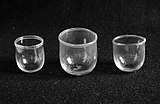 Glass
Glass Plastic
Plastic- Bamboo
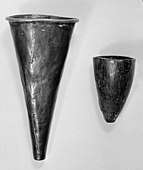 Horn/Copper
Horn/Copper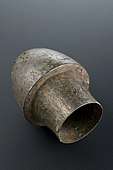 Bronze
Bronze
Dry cupping
The cupping procedure commonly involves creating a small area of low air pressure next to the skin. However, there are varieties in the tools used, the methods of creating the low pressure, and the procedures followed during the treatment.[15]
Fire cupping
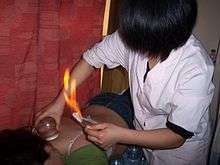
Fire cupping involves soaking a cotton ball in almost pure alcohol. The cotton is clamped by a pair of forceps and lit via match or lighter, and, in one motion, placed into the cup and quickly removed, while the cup is placed on the skin. The fire uses up all the oxygen in the cup which creates a negative pressure inside the cup. The cup is then quickly placed onto the body and the negative pressure "sucks" the skin up. Massage oil may be applied to create a better seal as well as allow the cups to glide over muscle groups (e.g. trapezius, erectors, latissimus dorsi, etc.) in an act called "gliding cupping" or "sliding cupping". Dark circles may appear where the cups were placed because of capillary rupture just under the skin. There are documented cases of burns caused by fire cupping.[16][17]
Wet cupping
Wet cupping is also known as Hijama (Arabic: حجامة lit. "sucking") or medicinal bleeding, where blood is drawn by local suction from a small skin incision.[18]
Wet cupping, unlike dry cupping, requires a skin incision. The skin incision can be made either before or after cupping treatment. The cup is meant to suck out any impurities in the body which may include blood, toxins, fragmented blood cells, and tissue fluid.
The first reported usages are found in the Islamic hadith, sayings attributed to or describing the actions of the Islamic prophet Muhammad.[19][20] Hadith from Muhammad al-Bukhari, Muslim ibn al-Hajjaj Nishapuri and Ahmad ibn Hanbal support its recommendation and use by Muhammad.[21] As a result, wet cupping has remained a popular remedy practiced in many parts of the Muslim world.[22]
In Finland, wet cupping has been done at least since the 15th century, and it is done traditionally in saunas. The cupping cups were made of cattle horns with a valve mechanism in it to create a partial vacuum by sucking the air out.[23] Cupping is still practiced in Finland as part of relaxing and/or health regimens.[24]
 A person receiving wet cupping
A person receiving wet cupping Blood drawn by wet cupping
Blood drawn by wet cupping
Traditional Chinese medicine
According to traditional Chinese medicine (TCM), cupping is done to dispel stagnation (stagnant blood and lymph), thereby improving qi flow,[25] in order to treat respiratory diseases such as the common cold, pneumonia and bronchitis. Cupping also is used on back, neck, shoulder and other musculoskeletal conditions. Its advocates claim it has other applications as well.[25] Cupping is not advised, in TCM, over skin ulcers or to the abdominal or sacral regions of pregnant women.[26]
Society and culture
Cupping has gained publicity in modern times due to its use by American sport celebrities including National Football League player DeMarcus Ware and Olympians Alexander Naddour, Natalie Coughlin, and Michael Phelps.[27] Medical doctor Brad McKay wrote that Team USA was doing a great disservice to their fans who might "follow their lead", calling cupping an "ancient (but useless) traditional therapy."[28] Steven Novella noted "It is unfortunate that elite athletics, including the Olympics, is such a hot bed for pseudoscience."[29]
There is a description of cupping in George Orwell's essay "How the Poor Die", where he was surprised to find it practiced in a Paris hospital.[30]
History
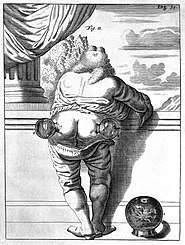
The origin of cupping is unclear. For over 3,000 years, the practice has been typically performed unsupervised, by individuals without any medical background. Iranian traditional medicine uses wet-cupping practices, with the belief that cupping with scarification may eliminate scar tissue, and cupping without scarification would cleanse the body through the organs.[31] Individuals with a profound interest in the practice are typically very religious and seek "purification."
There is reason to believe the practice dates from as early as 3000 BC. The Ebers Papyrus, written c. 1550 BC and one of the oldest medical textbooks in the Western world, describes the Egyptians' use of cupping, while mentioning similar practices employed by Saharan peoples. In ancient Greece, Hippocrates (c. 400 BC) used cupping for internal disease and structural problems. The method was highly recommended by Muhammad[20] and hence well-practiced by Muslim scientists who elaborated and developed the method further. Consecutively, this method in its multiple forms spread into medicine throughout Asian and European civilizations. In China, the earliest use of cupping that is recorded is from the famous Taoist alchemist and herbalist, Ge Hong (281–341 A.D.).[32] Cupping was also mentioned in Maimonides' book on health and was used within the Eastern European Jewish community.[33]
As of 2012 cupping was most popular in China. Cupping has been a formal modality in Chinese hospitals since 1950.[34]
See also
- Bloodletting
- Gua Sha
- List of ineffective cancer treatments
- Moxibustion
- Ear candling
References
- Crislip, Mark (24 December 2014). "Acupuncture Odds and Ends". Science-Based Medicine. Retrieved 8 August 2016.
- Hall, Harriet (21 August 2012). "Quackery and Mumbo-Jumbo in the U.S. Military". Slate.
- Chen, B; Li, MY; Liu, PD; Guo, Y; Chen, ZL (July 2015). "Alternative medicine: an update on cupping therapy". QJM : Monthly Journal of the Association of Physicians. 108 (7): 523–5. doi:10.1093/qjmed/hcu227. PMID 25399022.
- Lee, MS; Kim, JI; Ernst, E (March 2011). "Is cupping an effective treatment? An overview of systematic reviews". Journal of Acupuncture and Meridian Studies. 4 (1): 1–4. doi:10.1016/s2005-2901(11)60001-0. PMID 21440874.
- Russell J; Rovere A, eds. (2009). "Cupping". American Cancer Society Complete Guide to Complementary and Alternative Cancer Therapies (2nd ed.). American Cancer Society. pp. 189–191. ISBN 9780944235713.
- Singh, Simon; Ernst, Edzard (2008). Trick or Treatment. Transworld Publishers. p. 368. ISBN 978-0-552-15762-9.
- Crislip, Mark (24 December 2014). "Acupuncture Odds and Ends". Science-Based Medicine. Retrieved 8 August 2016.
- Hall, Harriet. "Therapy or Injury? Your Tax Dollars at Work". Science-Based Medicine. Retrieved 8 August 2016.
- Online Editors (8 August 2016). "Revealed - Why some Olympic athletes have those little red marks on them". Irish Independent.CS1 maint: extra text: authors list (link)
- Gorski, David (July 1, 2016). "What's the harm? Cupping edition". Respectful Insolence. Science-Based Medicine. Retrieved 8 August 2016.
- "Cupping". NCCIH. 8 November 2018.
- "What is cupping therapy". WebMD. Retrieved 15 August 2016.
- Shaban, Tamer (2013). Cupping Therapy Encyclopedia. CreateSpace. p. 29. ISBN 978-1494780517.
- "Classification of Cupping Therapy: A Tool for Modernization and Standardization (PDF Download Available)". ResearchGate. Retrieved 2017-03-29.
- Cui Jin and Zhang Guangqi, "A survey of thirty years’ clinical application of cupping", Journal of Traditional Chinese Medicine 1989; 9(3): 151–154
- Iblher, N.; Stark, B. (2007). "Cupping treatment and associated burn risk: a plastic surgeon's perspective". J Burn Care Res. 28 (2): 355–8. doi:10.1097/BCR.0B013E318031A267. PMID 17351459.
- Sagi, A.; Ben-Meir, P.; Bibi, C. (Aug 1988). "Burn hazard from cupping--an ancient universal medication still in practice". Burns Incl Therm Inj. 14 (4): 323–5. doi:10.1016/0305-4179(88)90075-7. PMID 3224303.
- Albinali, Hajar (June 2004). "Traditional Medicine Among Gulf Arabs Part II - Blood Letting". Heart Views. 5 (2): 74–85. Archived from the original on 11 September 2007.
- Rippin, Andrew; Knappert, Jan (1986). Textual Sources for the Study of Islam. Manchester University Press. p. 78. ISBN 978-0-7190-1884-8.
- Qayyim Al-Jauziyah (2003). Abdullah, Abdul Rahman (formerly Raymond J. Manderola) (ed.). Healing with the Medicine of the Prophet. ISBN 978-9960892917.
Indeed, the best of remedies you have is hijama, and if there was something excellent to be used as a remedy then it is hijama.
- Sunan Abu Dawood, 11:2097, 28:3848, Sahih Muslim, 26:5467, 10:3830, Sahih al-Bukhari, 7:71:584, 7:71:602
- El-Wakil, Ahmed (9 December 2011). "Observations of the popularity and religious significance of blood-cupping (al-ḥijāma) as an Islamic medicine". Contemporary Islamic Studies. Hamad bin Khalifa University Press. 2. doi:10.5339/cis.2011.2.
- Kaups, Matti (1976). "A Finish Savusauna in Minnesota" (PDF). Minnesota History. Minnesota Historical Society (Spring): 11–20.
- "...a cupping session — a recently revived, if archaic procedure, during which a therapist uses a cupping hatchet to make small cuts in your back and places glass cups fitted with bulb syringes over the cuts to draw out 'bad blood' and release 'feel-good' endorphins. Cupping is considered perfectly safe and aficionados say the procedure energizes them, but it’s definitely not for germophobes or the squeamish." : From "Finland's magnificent obsession", Travelsquire
- State Administration of Traditional Chinese Medicine and Pharmacy, Advanced Textbook on Traditional Chinese Medicine and Pharmacology, Volume IV, 1997 New World Press, Beijing
- Chinese Acupuncture and Moxibustion (Revised Edition), Xingnong, Foreign Languages Press, Beijing, China, 1987, p370.
- Reynolds, Gretchen; Crouse, Karen (August 8, 2016). "What Are the Purple Dots on Michael Phelps? Cupping Has an Olympic Moment". Well. The New York Times. Retrieved 8 August 2016.
- McKay, Brad (August 9, 2016). "Why Team USA's use of cupping therapy really sucks". News.com.au. Retrieved 9 August 2016.
- Novella, Steven (August 10, 2016). "Cupping – Olympic Pseudoscience". Science Based Medicine.
- Orwell, George (November 1946). "How the Poor Die". Now. Retrieved 10 August 2016.
As I lay down I saw on a bed nearly opposite me a small, round-shouldered, sandy-haired man sitting half naked while a doctor and a student performed some strange operation on him. First the doctor produced from his black bag a dozen small glasses like wine glasses, then the student burned a match inside each glass to exhaust the air, then the glass was popped on to the man's back or chest and the vacuum drew up a huge yellow blister. Only after some moments did I realize what they were doing to him. It was something called cupping, a treatment which you can read about in old medical text-books but which till then I had vaguely thought of as one of those things they do to horses.
- Nimrouzi M; Mahbodi A; Jaladat AM; Sadeghfard A; Zarshenas MM (2014). "Hijama in traditional Persian medicine: risks and benefits". J Evid Based Complementary Altern Med. 19 (2): 128–36. doi:10.1177/2156587214524578. PMID 24647093.
- Dharmananda, Subhuti. "Cupping". itmonline.org. Institute for Traditional Medicine. Retrieved 2016-08-10.
- Ingall, Marjorie (2016-08-11). "Everything You Ever Wanted to Know About Cupping—and Some Stuff You Probably Didn't". Tablet Magazine. Retrieved 2016-08-14.
- Cao, Huijuan; Li, Xun; Liu, Jianping (2012). "An updated review of the efficacy of cupping therapy". PLOS ONE. 7 (2): e31793. doi:10.1371/journal.pone.0031793. ISSN 1932-6203. PMC 3289625. PMID 22389674.
